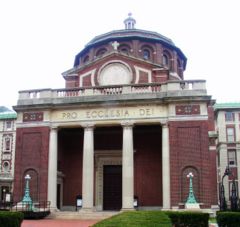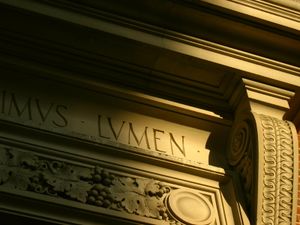Difference between revisions of "St. Paul's Chapel"
Absentminded (talk | contribs) |
Absentminded (talk | contribs) |
||
| Line 3: | Line 3: | ||
{{wp-also2|St. Paul's Chapel (Columbia University)}} | {{wp-also2|St. Paul's Chapel (Columbia University)}} | ||
| − | '''St Paul's Chapel''' is Columbia's non-denominational religious space. It was built between [[1904]] and [[1907]], and dedicated in 1907. | + | '''St Paul's Chapel''' is Columbia's non-denominational religious space. In [[1903]], two wealthy philanthropists, Olivia Egleston Phelps Stokes and Caroline Phelps Stokes, offered to finance a chapel on the [[Morningside Heights campus]] as a memorial to their parents. It was built between [[1904]] and [[1907]], and dedicated in 1907. An illuminated letter stipulating the Stokes sisters' gift is framed and hanging from a column to the left of the main aisle and near the entrance. |
==Architecture== | ==Architecture== | ||
| Line 9: | Line 9: | ||
[[Image:Lumen.JPEG|thumb|LVMEN!]] | [[Image:Lumen.JPEG|thumb|LVMEN!]] | ||
| − | St. Paul's is one of the few early campus buildings not designed by [[McKim, Mead, and White]] | + | The Stokes sisters’ one condition was that their nephew, I. N. Phelps Stokes, of the architectural firm of [[w:Howells & Stokes|Howells & Stokes]], design the building. As a result, St. Paul's is one of the few early campus buildings not designed by [[McKim, Mead, and White]]. A mixture of Italian Renaissance, Byzantine, and, to some extent, Gothic styles, it is referred to in the Eyewitness Guide to New York as "Columbia's most spectacular building". |
| − | St. Paul's has a number of interesting architectural features, including a number of inscribed [[Latin phrases]] on the exterior. The University motto, ''In lumine tuo videbimus lumen'', is carved above the main door. The larger motto, above the church's front columns, is ''Pro | + | St. Paul's has a number of interesting architectural features, including a number of inscribed [[Latin phrases]] on the exterior. The University motto, ''In lumine tuo videbimus lumen'', is carved above the main door. The larger motto, above the church's front columns, is ''Pro Ecclesia Dei'', "for the church of God". |
| − | The | + | Each of the four columns is capped with a carving of a Cherub's head executed by [[w:Gutzon Borglum|Gutzon Borglum]], better known as the sculptor of [[w:Mount Rushmore|Mount Rushmore]]. |
| + | |||
| + | The two bronze torcheres in front of the building were donated by the Class of 1883 on its 25th anniversary and are the works of Florentine sculptor Arturo Bianchini. The lamp to the left has four statuettes representing prophets of the Old Testament, while that to the right has four apostles of the New Testament. The inset scallop shells behind the lamps are a symbol of welcome to pilgrims. The torcheres are currently corroding away thanks to a general lack of funding to maintain Columbia's architecture.<ref>[http://columbiaspectator.com/node/29437 Architectural Legacy Proves Difficult to Maintain], COlumbia Specator, February 20, 2008</ref> | ||
| + | |||
| + | Stokes had planned for four carved lunettes on the exterior of the chapel, where the flat slabs of marble on the north and south facade are, but only the southwest lunette, a gift from Stokes, was ever completed. | ||
The interior of the chapel, one of the prettiest on campus, features a Guastavino tiled roof and [[w:John LaFarge|John LaFarge]] stained glass windows behind the altar. The stained glass windows in the roof rotunda features the coats of arms of prominent New York families from the early 20th century. | The interior of the chapel, one of the prettiest on campus, features a Guastavino tiled roof and [[w:John LaFarge|John LaFarge]] stained glass windows behind the altar. The stained glass windows in the roof rotunda features the coats of arms of prominent New York families from the early 20th century. | ||
Revision as of 15:57, 12 March 2008

St Paul's Chapel is Columbia's non-denominational religious space. In 1903, two wealthy philanthropists, Olivia Egleston Phelps Stokes and Caroline Phelps Stokes, offered to finance a chapel on the Morningside Heights campus as a memorial to their parents. It was built between 1904 and 1907, and dedicated in 1907. An illuminated letter stipulating the Stokes sisters' gift is framed and hanging from a column to the left of the main aisle and near the entrance.
Architecture
The Stokes sisters’ one condition was that their nephew, I. N. Phelps Stokes, of the architectural firm of Howells & Stokes, design the building. As a result, St. Paul's is one of the few early campus buildings not designed by McKim, Mead, and White. A mixture of Italian Renaissance, Byzantine, and, to some extent, Gothic styles, it is referred to in the Eyewitness Guide to New York as "Columbia's most spectacular building".
St. Paul's has a number of interesting architectural features, including a number of inscribed Latin phrases on the exterior. The University motto, In lumine tuo videbimus lumen, is carved above the main door. The larger motto, above the church's front columns, is Pro Ecclesia Dei, "for the church of God".
Each of the four columns is capped with a carving of a Cherub's head executed by Gutzon Borglum, better known as the sculptor of Mount Rushmore.
The two bronze torcheres in front of the building were donated by the Class of 1883 on its 25th anniversary and are the works of Florentine sculptor Arturo Bianchini. The lamp to the left has four statuettes representing prophets of the Old Testament, while that to the right has four apostles of the New Testament. The inset scallop shells behind the lamps are a symbol of welcome to pilgrims. The torcheres are currently corroding away thanks to a general lack of funding to maintain Columbia's architecture.[1]
Stokes had planned for four carved lunettes on the exterior of the chapel, where the flat slabs of marble on the north and south facade are, but only the southwest lunette, a gift from Stokes, was ever completed.
The interior of the chapel, one of the prettiest on campus, features a Guastavino tiled roof and John LaFarge stained glass windows behind the altar. The stained glass windows in the roof rotunda features the coats of arms of prominent New York families from the early 20th century.
One of the more curious and overlooked feature of St. Paul's interior are the marble memorial plaques installed throughout the interior, recognizing various administrators and teachers after their deaths. If there's someone you'd like to honor with such a plaque, feel free to contact facilities and get a quote; the most recent plaque was installed in 1988. Alternatively get a tree planted on campus with a bronze and granite marker for $3,500.
Ceremonial uses
The Class of 1893 Bell, located outside roughly above the left column of the front portico, rings at 9:30am on the day of University Commencement to signal the beginning of the student procession. If you enter St Paul's and turn left to the stairway in corner, you'll find the bell rope hanging from the ceiling, attached to the bell through a small hole in the ceiling. A plaque recognizing the gift is installed on the stairway.
During commencement, the church is also the location of the Baccalaureate Ceremony.
Other popular uses include concerts and, of course, religious ceremonies. It is also popular for weddings and memorial services.
The crypt
St. Pauls' crypt (basement) is used by a number of student groups. The Postcrypt Coffeehouses take place in a small intimate space, and the Postcrypt Art Gallery is located in the Guastavino Room, a well lit space distinguished by its strange acoustics thanks to its vaulted Guastavino tiled ceiling. Also located in the crypt is the Choir Room a beautiful somewhat semi-circular space located under the chapel altar and with small stained glass windows. The Blue and White holds formal weekly meetings in the crypt, as do various student religious groups holding studies and discussions. This led to a minor controversy in 2005 when the University Chaplain installed canvas curtains in the room that could be pulled by religious groups who were using the space when tasteful nudes and blown-up genitalia were featured on the walls. This led to Postcrypt crying censorship, although everyone eventually calmed down and agreed the decision was a sensible compromise in order to maximize the utility of the space.[2][3][4]
The crypt is accessible by going through the entry door on the far right and then down the stairs.
In film
The 1996 film The Mirror has Two Faces was filmed at an organ recital at St. Paul's. The chapel's Aeolian-Skinner pipe organ is reknown for its sound.
Map
<googlemap lat="40.807902" lon="-73.961184" type="map" zoom="16" width="500" height="300" controls="small"> 40.807902, -73.961184, St Paul's Chapel </googlemap>
References
- ↑ Architectural Legacy Proves Difficult to Maintain, COlumbia Specator, February 20, 2008
- ↑ Curtains Drawn at Postcrypt Gallery, Columbia Spectator, February 9, 2005
- ↑ Curtain Drawn on Free Speech, Columbia Spectator, February 11, 2005
- ↑ STAFF EDITORIAL: Don't Be Ridiculous, Columbia Spectator, February 15, 2005
